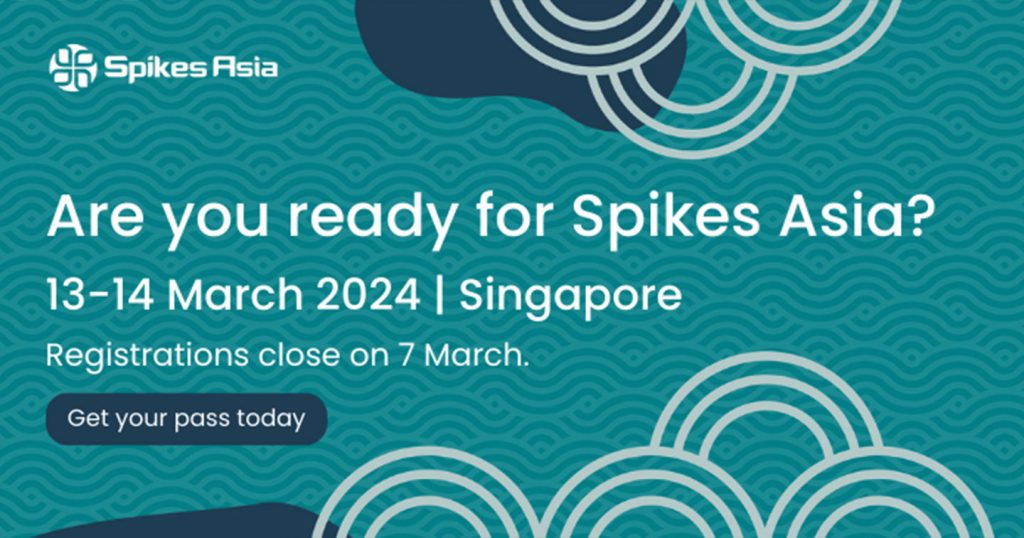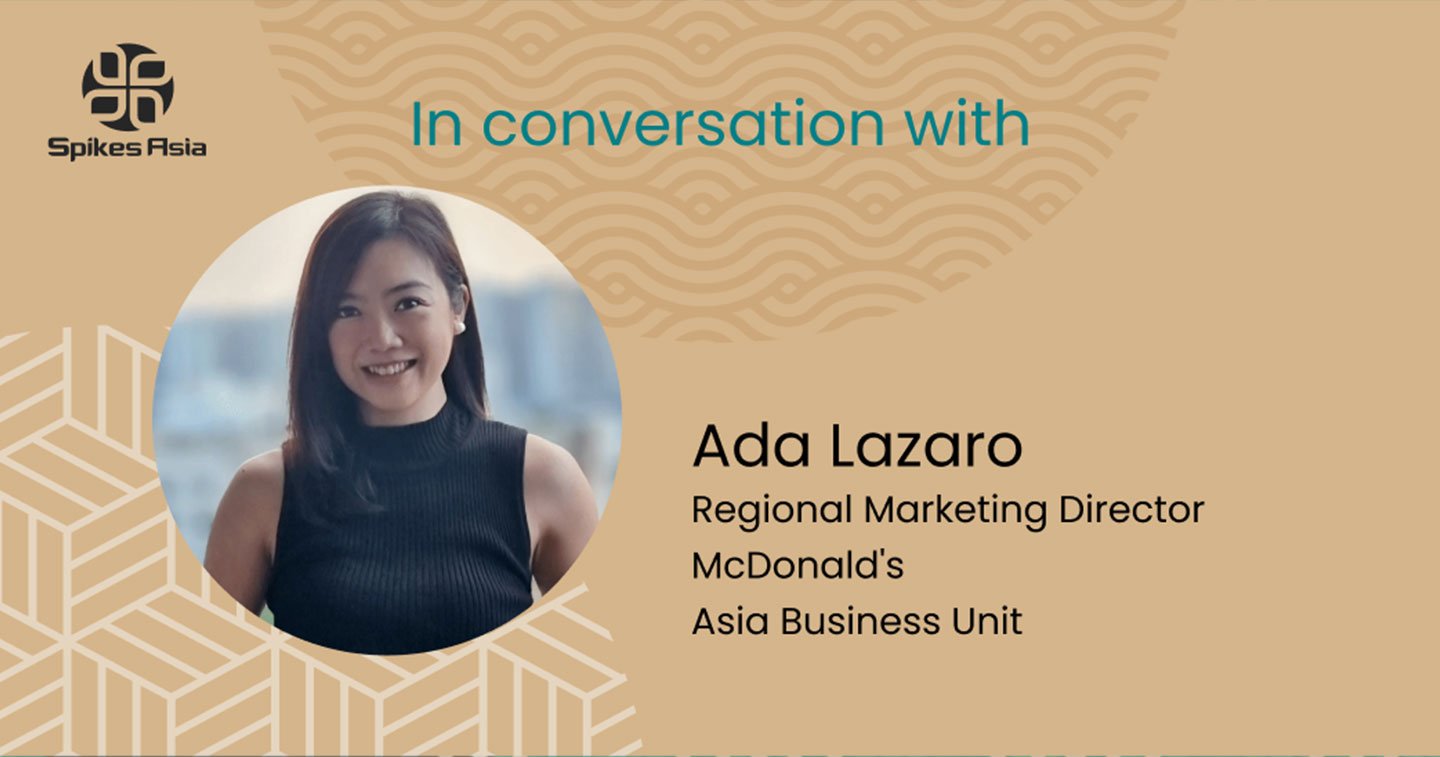SINGAPORE — With just one week left until Spikes Asia Festival of Creativity 2024, delegates, creatives, and marketers are posed for an exciting lineup of sessions in the jam-packed conference, including how McDonald’s “Culturally Connects to Gen Z by Riding the K-Wave” slated on Day 1. McDonald’s Regional Marketing Director Ada Lazaro shares what to expect in their upcoming talk and how the brand taps into certain communities, including gamers in the Philippines.
Participating in culture is becoming tablestakes for brands to stay relevant. In the world of McDonald’s, how would you define culture in the modern marketing mix?
Culture encompasses more than just advertising and branding. Rather, it’s about integrating with societal trends, values, and consumer behaviors. This involves understanding and resonating with diverse cultural nuances, including local customs, preferences, and lifestyle differences. Culture forms 100% of our marketing mix. We believe that we should be living in culture and with cultures. We invite that thinking throughout different aspects of the brand, from the menu items to how we approach community engagement and deliver personalized experiences on digital platforms.

Are there any myths about culture marketing that you would like to dispel?
I would dispel the notion that culture in marketing is solely about trends or gimmicks, the riding of a wave, and simply riding the pop culture bandwagon.
Another myth is that culture is a one-size-fits-all approach. McDonald’s recognizes the importance of localization and tailoring strategies to specific regions or demographics. We do that to engage with diverse cultures and communities authentically.
For our brand, we would rather go narrow and then wide. Narrow and focus on the target audience that we are engaging with so that we can then make a wider and more lasting impact in that community.
We recently activated McDonald’s Philippines with an unbranded menu to connect with a specific gaming community. We are also engaging with anime fans. So it’s about focusing on creating a genuine connection with these communities and initiating a conversation between one fan and another; the idea is really focused on a fan base.
In your experience, how was culture marketing done in the past?
Before, if you were being present in culture, that meant that the brand was part of a big occasion. But now it’s more about being part of a customer’s ritual. For example, it’s not just about putting an ad during the Super Bowl. Rather, being in culture would mean that consumers actually eat McDonald’s while watching the sport. That’s when a brand becomes integral and becomes part of the conversation and experience.
Here’s another example: It’s not about putting a branded cup of McDonald’s to a KOL who’s doing video streaming, but it’s the fact that gamers look for McDonald’s products or what looks like a McDonald’s product within the games. That’s how we know we’ve become part of culture. It’s about integrating ourselves more authentically and seamlessly. It’s not hard sell. It’s just being part of the conversation.
Culture marketing in the past is conflated with trend jacking, which can become short-sighted and inauthentic to the communities that brands are trying to reach. How do you ensure that participating in culture delivers enduring growth?
Culture has become part of the overall briefing process. It’s no longer just about cracking the consumer insight and the role of the brand but about understanding the cultural insight. When you find that intersection, you are guaranteed that the message is relevant to the consumer, the connection to the culture is authentic, and the role that the brand plays is actually intrinsic to the overall big idea.
Once you’ve screened yourself against these components, you’re able to ensure that you’re not falling into tactical thinking. So you screen your idea — Is this a one-off campaign? Or does this have platform potential that can actually run over time? We should remember that when big ideas are relevant to consumers and the brand, they are built to last.
How does McDonald’s measure the effectiveness of this approach?
You can definitely see the impact on sales when you take this approach. But on a macro level, you can also see the longer-term impact of brand trust and affinity. These are metrics we build over time, and we have seen that stronger brand trust and brand affinity scores actually make the most functional campaigns harder working because the consumer trust and affinities are already there. When there is trust, it makes it easier for consumers to invest in the brand.
There was an example from the Wall Street Journal article that said McDonald’s is cool again and that stock prices were at an all-time high. This tells us that the brand is in a strong position. Consumers are consuming not just the products that we actually sell but making McDonald’s part of their lives.
How can marketers gain more confidence in participating in culture where simply putting a logo is not enough?
The confidence comes from the fact we didn’t work on this overnight. It’s something that we’ve built on over years and years. We do things on a platform level and not just the one-off campaigns. This approach has a buildable equity that grows with you.
Even though we are a global brand and have localized at a market level, everywhere you go, it’s the same taste of McDonald’s fries. There’s a consistency in the approach, not just with the food menu but also in how we deliver or communicate our message.
McDonald’s will always have that same feel-good moment wherever in the world you go, and we try to deliver that message consistently across various touchpoints. This gives us the confidence to be okay with a tiny red fry box in there and not a huge screaming McDonald’s logo. We know that consumers are able to identify with, connect with, and resonate with us.
Recently, McDonald’s Korea partnered with K-pop band NewJeans in a hotly anticipated collaboration across eight Asian markets. What were the aspects of the campaign that were standardized across the region versus localized to fit market nuances?
The campaign was between 60 and 70% standardized for the region and around 30 to 40% localized. The big idea and all of the creative assets were standardized.
The big idea is that McDonald’s chicken is so good that it will get everyone dancing. Who better to get everyone dancing, especially Gen Z, than their favorite NewJeans band? They have wide appeal across many regional countries and their music or K-pop. Music, in general, transcends cultures. We had one song, one TVC, one digital engagement video. We had uniform key visuals on social media, out-of-home, front counter, and packaging. We had to make or allow markets to localize to ensure that it would resonate with local consumers.
First, we started with the product. It had to be the sought-after chicken in the market, so countries like Korea, Taiwan, and Hong Kong featured a crispy chicken burger. But in the more rice-eating countries like Thailand and Indonesia, they feature their iconic local bone-in chicken like the Ayam McD of Indonesia. It had to be the chicken product local consumers love.
The next level of localization is in the below-the-line activations. We also localize below-the-line activations and consumer engagement because that is where there are unique nuances.
For example, there was a dance challenge for both the Philippines and Indonesia markets. But in Indonesia, the local team found that most of their restaurant crews were true fans of NewJeans. The communication was that whatever they did for their consumers, they should do the same for their crew because they are authentic fans, too. Now, we had over 1,000 organic ambassadors talking about the mechanics of the promotion.
Another example was in Thailand. When they zoomed in on the profiles of the NewJeans fans, they found that the majority were males, but Thai males generally don’t want to be seen dancing. Had they not known this information about the customer, the local team could have easily used the same mechanics from the Philippines and Indonesia, which wouldn’t have worked.
It’s important to dive deep into your local data and uses it to localize and tweak the mechanics such that it becomes relevant and successful.
What challenges did the brand face when trying to localize this campaign, and how did it overcome them?
This campaign was done at a regional level, so we only had to deal with eight markets versus a global McDonald’s roll-out.
So the pain points, of course, were getting approvals on visuals across the eight markets. But there is more flexibility than if you had to adhere to global guidelines.
Is there a difference between adapting from a regional versus global level?
As a global brand, we are trying to change our approach to localization. Before, the approach was about taking one big idea from corporate or global McDonald’s, and everyone just had to launch or scale it downwards. An advantage is that you can optimize big campaign resources because of the production scale. But the risk is that it might not resonate with everyone. What works for the Americans might not work for the Asians.
Now, we take a bottom-up approach and give power to the local markets instead of cascading from the top-down. These ideas from a market level are shared with a creative council. Those that have potential are then brought up and pitched to everyone else. Whoever thinks it’s relevant has the option to scale.
So it’s really about sharing best practices and shamelessly encouraging each market to steal from each other. It’s one practice that we’re not shy about. That’s how we use our global scale – shamelessly stealing local ideas that are very much scalable because it’s one McDonald’s brand at the end of the day.
How do you know what local ideas can scale across markets?
Using NewJeans as an example, it was initially a team Korea initiative. It was a campaign that they ran. When they launched it, the social media managers from the different Asian markets were very busy answering messages from fans asking when they would bring it to their market.
The idea to scale actually came from our fans. It’s social listening, together with your gut feel, that tells you that this also works for your market.
Get your tickets to Spikes Asia Festival of Creativity here.
adobo magazine is an official media partner of Spikes Asia 2024.








